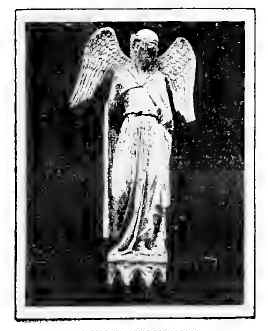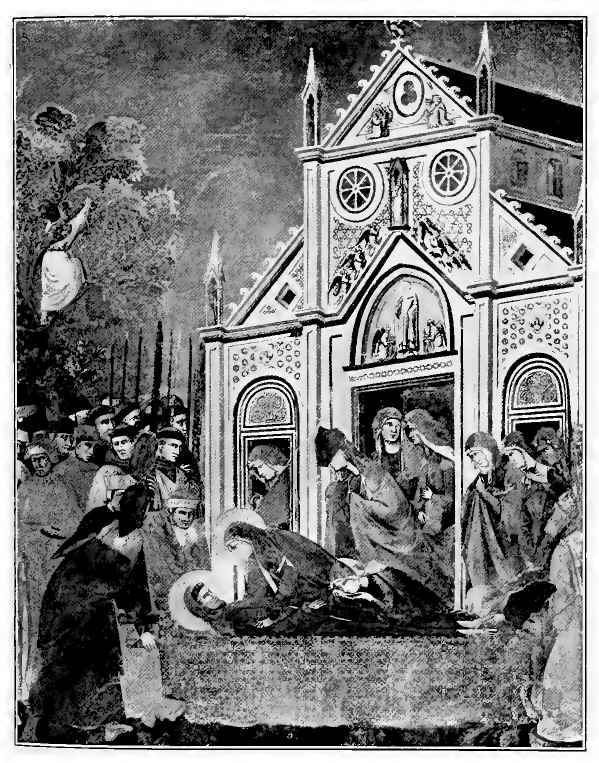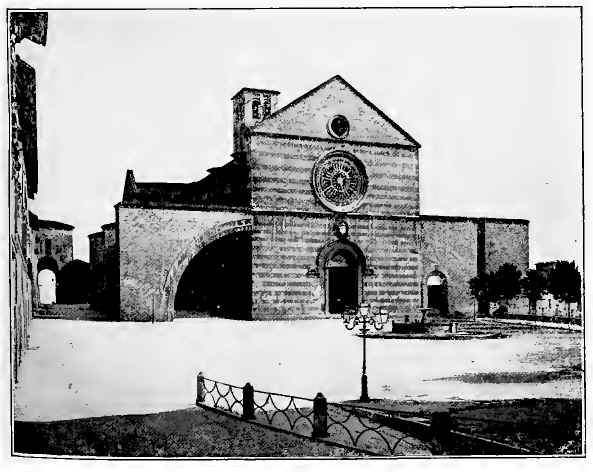 Полная версия
Полная версияПолная версия:
The Thirteenth, Greatest of Centuries
As for the birds his pages are full of references to them and all of his bird similies are couched in terms that show how sympathetically observant he was of their habits and ways. He knows their different methods of flying in groups and singly, he has observed them on their nests and knows their wonderful maternal anxiety for their young, and describes it with a vividness that would do credit to a naturalist of the modern time who had made his home in the woods. Indeed some of his figures taken from birds constitute examples of the finest passages of poetic description of living nature that have ever been written. The domestic animals, moreover, especially the cat and the dog, come in for their share of this sympathetic observance, and he is able to add greatly to the vividness of the pictures he paints by his references to the well-known habits of these animals. It is no wonder that the tradition has grown up that he was fond of such pets and possessed several of them that were well-known to the early commentators on his poems, and the subject of no little erudition.
Nothing escaped the attention of this acute observer in the world around him, and over and over again one finds surprising bits of observation with regard to natural phenomena usually supposed to be quite out of the range of the interest of medieval students generally, and above all of literary men of this Middle Age. Alexander Von Humboldt calls attention in a well-known passage in his Cosmos to the wonderful description of the River of Light in the Thirtieth Canto of the Paradiso.
"I saw a glory like a stream flow by. In brightness rushing and on either shore Were banks that with spring's wondrous hues might vie. And from that river living sparks did soar, And sank on all sides in the flow'rets' bloom, Like precious rubies set in golden ore. Then, as if drunk with all the rich perfume, Back to the wondrous torrent did they roll, And as one sank another filled its room."Humboldt explains this as follows, with a suggestion that deserves to be remembered.
"It would almost seem as if this picture had its origin in the poet's recollection of that peculiar and rare phosphorescent condition of the ocean in which luminous points appear to rise from the breaking waves, and, spreading themselves over the surface of the waters, convert the liquid plain into a moving sea of sparkling stars."
Probably the best way for a modern to realize how much of interest there may be for him in Dante is to consider the great Italian epic poet in comparison with our greatest of English epic poets, Milton. While any such comparison in the expressive Latin phrase is sure to walk lame, it serves to give an excellent idea of the methods of the two men in the illustration of their ideas. We venture therefore to quote a comparison between these two poets from a distinguished critic who knows both of them well, and whose modern training in English methods of thought, would seem to make him likely to be partial to the more modern poet though as a matter of fact he constantly leans toward the great medieval bard.
"The poetry of Milton differs from that of Dante as the hieroglyphics of Egypt differ from the picture-writing of Mexico. The images which Dante employs speak for themselves; they stand simply for what they are. Those of Milton have a signification which is often discernible only to the initiated. … However strange, however grotesque, he never shrinks from describing it. He gives us the shape, the color, the sound, the smell, the taste; he counts the numbers; he measures the size. His similies are the illustrations of a traveler. Unlike those of other poets, and especially of Milton, they are introduced in a plain business-like manner, not for the sake of any of the beauty in the objects from which they are drawn; not for the sake of any ornament they may impart to the poem; but simply in order to make the meaning of the writer as clear to the reader as it is to himself."
"Still more striking is the similarity between Dante and Milton. This may be said to lie rather in the kindred nature of their subjects, and in the parallel development of their minds, than in any mere external resemblance. In both the man was greater than the poet, the souls of both were 'like a star and dwelt apart.' Both were academically trained in the deepest studies of their age; the labour which made Dante lean made Milton blind. The 'Doricke sweetnesse' of the English poet is not absent from the tender pages of the Vita Nuova. The middle life of each was spent in active controversy; each lent his services to the state; each felt the quarrels of his age to be the 'business of posterity,' and left his warnings to ring in the ears of a later time. The lives of both were failures. 'On evil days though fallen, and evil tongues,' they gathered the concentrated experience of their lives into one immortal work, the quintessence of their hopes, their knowledge, and their sufferings. But Dante is something more than this. Milton's voice is grown faint to us—we have passed into other modes of expression and of thought."
The comparison with Vergil is still more striking and more favorable to the Italian poet. "Dante's reputation has passed through many vicissitudes, and much trouble has been spent by critics in comparing him with other poets of established fame. Read and commented upon in the Italian universities in the generation immediately succeeding his death, his name bcame obscured as the sun of the Renaissance rose higher towards its meridian. In the Seventeenth Century he was less read than Petrarch, Tasso, or Ariosto; in the Eighteenth he was almost universally neglected. His fame is now fully vindicated. Translations and commentaries issue from every press in Europe and America. Dante Societies are formed to investigate the difficulties of his works. He occupies in the lecture-rooms of regenerated Italy a place by the side of those great masters whose humble disciple he avowed himself to be. The Divine Comedy is indeed as true an epic as the AEneid, and Dante is as real a classic as Vergil. His metre is as pliable and flexible to every mood of emotion, his diction as plaintive and as sonorous. Like him he can immortalize by a simple expression, a person, a place, or a phase of nature. Dante is even truer in description than Vergil, whether he paints the snow falling in the Alps, or the homeward flight of birds, or the swelling of an angry torrent. But under this gorgeous pageantry of poetry there lies a unity of conception, a power of philosophic grasp, an earnestness of religion, which to the Roman poet were entirely unknown."
If we would have a very recent opinion as to the position of Dante as a literary man and as a great intellectual force, perhaps no better can be obtained than from some recent expressions of Mr. Michael Rossetti, whose Italian descent, English training, and literary and artistic heredity, seem to place him in an ideal position for writing this generation's ultimate judgment with regard to the great poet of the Thirteenth Century. In his Literature of Italy he said:—
"One has to recur time after time, to that astounding protagonist, phenomenon and hero, Dante Alighieri. If one were to say that Italian literature consists of Dante, it would, no doubt, be an exaggeration, and a gross one, and yet it would contain a certain ultimate nucleus of truth."
"Dante fixed the Italian language, and everyone had to tread in his vestiges. He embodied all the learning and thought of his age and transcended them. He went far ahead of all his predecessors, contemporaries, and successors; he wrote the first remarkable book in Italian prose, La Vita Nuova; and a critical exposition of it in the Convito; in Latin, a linguistic treatise, the De Vulgari Eloquio, which upholds the Vulgare Illustre, or speech of the best cultivated classes, markedly in Tuscany and Bologna, against the common dialects; and a political study, De Monarchia, of the most fundamental quality, which even to us moderns continues to be sane and convincing in its essence, though its direct line of argument has collapsed; and finally, and most important by far, he produced in La Commedia Divina the one poem of modern Europe that counter-balances Shakespeare and challenges antiquity. This is the sole book which makes it a real pity for anyone to be ignorant of Italian. Regarded singly, it is much the most astonishing poem in the world, dwarfing all others by its theme, pulverizing most of them by its majesty and sustainment, unique in the force of its paraded personality and the thunderous reverberation of its judgments on the living and the dead."

ANGEL (RHEIMS)
XX
THE WOMEN OF THE CENTURY
In generations whose men proved so unending in initiative and so forceful in accomplishment, so commanding in intelligence, so persistent in their purposes, so acute in their searching, so successful in their endeavors, the women of the time could not have been unworthy of them. Some hints of this have been already given, in what has been said about the making of furnishings for the church, especially in the matter of needlework and the handpainting of various forms of ornaments. There are further intimations in the histories of the time, though unfortunately not very definite information, with regard to even more ambitious accomplishments by the women of the period. There are, for instance, traditions that the designs for some of the Cathedrals and certainly for portions of many of them came from women's hands. It is in the ethical sphere, however, that women accomplished great things during the Thirteenth Century. Their influence stood for what was best and highest in the life of the time and their example encouraged not only their own generation, but many people in many subsequent generations "to look up, not down, to look within, not without" for happiness, and to trust that "God's in his heaven and all's well with the world."
There are a number of women of the time whose names the race will not let die. While if the ordinary person were asked to enumerate the great women of the Thirteenth Century it would be rare to find one able properly to place them, as soon as their names are mentioned, it will be recognized that they succeeded in accomplishing work of such significance that the world is not likely to let the reputation of it perish. Some of these names are household words. The bearers of them have been written of at length in quite recent years in English as well as in other languages. Their work was of the kind that ordinarily stands quite apart from the course of history and so dates are usually not attached to it. It is thought of as a portion of the precious heritage of mankind rather than as belonging to any particular period. Three names occur at once. They are St. Clare of Assisi, St. Elizabeth of Hungary, and Queen Blanche of Castile, the mother of St. Louis. To these should be added Queen Berengaria, the sister of Blanche, and the mother of Ferdinand of Castile; Mabel Rich, the London tradesman's wife, the mother of St. Edmund of Canterbury; and Isabella, the famous Countess of Arundel.
The present day interest in St. Francis of Assisi, has brought St. Clare under the lime-light of publicity. There is no doubt at all that her name is well worthy to be mentioned along with his and that she, like him, must be considered one of the strongest and most beautiful characters of all time. She was the daughter of a noble family at Assisi, who, having heard St. Francis preach, became impressed with the idea that she too should have the opportunity to live the simple life that St. Francis pictured. Of course her family opposed her in any such notion. That a daughter of theirs should take up with a wandering preacher, who at that time was looked on not a little askance by the regular religious authorities, and whose rags, and poverty made him anything but a proper associate for a young lady of noble birth, could not but seem an impossible idea. Accordingly Clare ran away from home and told Francis that she would never go back and that he must help her to live her life in poverty just as he was doing himself. He sent her to a neighboring convent to be cared for, and also very probably so as to be assured of her vocation.
After a time a special convent home for Clare and some other young women, who had become enamored with the life of poverty and simplicity was established, and to this Clare's sister Agnes came as a postulant. By this time apparently the family had become reconciled to Clare's absence from home, but they would not stand another daughter following such a foolish example. Accordingly Agnes was removed from the convent by force after a scene which caused the greatest excitement in the little town. It was not long, however, before Agnes returned to the convent and within a few years their mother followed them, and became one of the most fervent members of the little community.

ST. CLARE'S FAREWELL TO THE DEAD ST. FRANCIS (GIOTTO)
The peace and happiness that came with this life of absolute poverty soon attracted many other women and Clare was asked to establish houses at a distance. Gradually the order of Poor Clares, the second order of St. Francis, thus came into existence. When it was necessary to draw up constitutions for the order, Clare showed not only the breadth of her intelligence, but the depth of her knowledge of human nature, and her appreciation of what was absolutely necessary in order to keep her order from degeneration. Against the counsels of all the ecclesiastics of her time, including many cardinals and even a Pope, she insisted on the most absolute poverty as the only basis for the preservation of the spirit of her second order of St. Francis. Her character was well manifested in this contest from which she came out victorious.
Her body has been miraculously preserved and may still be seen at Assisi. Anyone who has seen the strongly set lips and full firm chin of the body in the crypt of San Damiano, can easily understand the strength of purpose and of character of this young woman who moulded a generation to her will. The story is told of her, that once when the Saracens invaded Italy and attacked the convent, she mounted the walls with a monstrance containing the Blessed Sacrament in her hands, and the marauders turned away in consternation from the stern brave figure that confronted them, and bothered the nuns no more. After St. Francis' death she, more than anyone else, succeeded in maintaining the spirit of the Franciscan order in the way in which St. Francis would have it go. Long after her death a copy of the original rules was found in the fold of her garments and did much to restore the Franciscan life to its primitive simplicity and purpose, so that even after she was no more on earth, she was still the guardian and promoter of St. Francis' work.
If one wants to know how much of happiness there came to her in life one should read the famous passage which describes her visit to St. Francis, and how she and he with sisters and brothers around them broke bread together, with a sweetness that was beyond human. The passage is to be found in the "Little Flowers of St. Francis of Assisi" which was written within a century after the occurrences described. It recalls nothing so much as the story of the disciples at Emaus and is worthy to be thought of beside the Scripture story.26

CHURCH (DOBERAN, GERMANY)

SAN DAMIANO (ASSISI)
What Saint Clare accomplished as her life work was the making of a new vocation for women. There are always a certain number of women who look for peace and quiet rather than the struggle for existence. For these the older monasteries did not supply a place unless they were of the wealthier class as a rule. Among the Poor Clares women of all classes were received. In this way a great practical lesson in equality was taught. Women did not have to marry, perhaps unsuitable, often even objectionable men, simply in order to have a mode of life. They could join one of these communities and though in absolute poverty, with many hours each day devoted to meditation and prayer, had time to give to beautiful needlework, to painting and book illumination, and to other feminine occupations; and might thus pass long, happy lives, apart from the bustle of the strenuous time.
Italy at this time, it must be recalled, was a seething cauldron of political and military strife. Wars were waged, and struggles of all kinds engaged in for precedence and power. These women got away from this unfortunate state of affairs. Occasionally in times of pestilence, when they were specially needed, as happened at least once in Saint Clare's life, they took care of the ailing and lent their convent as a hospital. Above all they stood in the eyes of their generation for chosen people who saw things differently from others. They taught the great lesson of not caring too much for the things of this world and of not living one's life in order to get admiration though usually envy comes, nor idle praise for qualities they either do not possess or that are not worthy of notice. They showed people the real value of this life by its reflection upon the other. Many a man turned aside from ambitious schemes that would have injured others, because of the kindly influence of these unselfish women and because of the memory of a sister, or an aunt whose sacrificing life was thus a rebuke to his foolish selfishness. Other women learned something of the vanity of human things by learning to value the character of these Poor Clares and realizing how much of happiness came to them from the accomplishment of their simple duties. Professor Osler said, in his lecture on Science and Immortality, of these self-forgetting ones:—"The serene faith of Socrates with the cup of Hemlock at his lips, the heroic devotion of a St. Francis or a St. Teresa, but more often for each one of us the beautiful life of some good woman whose—
Eyes are homes of silent prayer, … Whose loves in higher love endure.do more to keep alive among the Laodiceans a belief in immortality than all the preaching in the land." This is what St. Clare accomplished for her own generation and her influence is still a great living force in the world.
What especially should attract the attention of the modern time is the perfect basis of equality on which the Franciscan and Dominican orders of men and of women were organized. Each community had the opportunity to elect its own superiors. The rules were practically the same for the first (for men) and the second (for women) order of St. Francis, except that while the first order were supposed to live on alms collected by begging from door to door, this menial obligation was not imposed upon the women, who were expected to be supported by alms brought to their convents by the faithful, and by the labor of their own hands. This equality of men and women in the monastic establishments became widespread after the Thirteenth Century and made itself felt in the social order of the time as a factor for feminine uplift. Undoubtedly Saint Clare's work in the foundation of the second order of St. Francis must be held responsible to no small degree for this. Before her death, there were half a dozen scions of royal families in various parts of Europe who had become members of her order, and literally hundreds of the daughters of the nobility, many of them of high rank, had put off their dignity and position in the world, to become poor daughters of Saint Clare. They did so for the peace and the happiness of the vocation, and the opportunity to seek their souls and live their lives in their own quiet way, which her convents afforded them.

ST. ELIZABETH'S CATHEDRAL (MARBURG)
After Saint Clare, the best known woman of the Thirteenth Century is undoubtedly Saint Elizabeth of Hungary, of whom the world knows some pretty legends, while the serious historian recognizes that she was the first settlement worker of history. As a child she wandered down from the castle walls in which she lived and saw the poor in their suffering. She felt so much for them that she stripped herself of most of her garments and finally even of her shoes in order to clothe them. When she was taken to task for this, she said that she had suffered whatever inconvenience there was in it only for a few minutes while the poor had suffered all their lives. She became the wife of the Duke of Thuringia, and there were three years of ideal happiness with her husband and her children. When he went away on the Crusade she gave herself up to the care of the poor. When he died, though she was only twenty, and according to tradition one of the handsomest women of her time, she devoted herself still more to her poor and even went to live among them. She tried to teach them, as do the settlement workers of the modern time, something of the true significance of life, to bring them to realize to some degree at least, that so many of the things they so vainly desire are not worth thinking about, but that happiness consists in lopping off one's desires rather than trying vainly, as it must ever be, to satisfy them. It is no wonder that throughout all Germany she came to be called "the dear St. Elizabeth." Literally thousands of women since her time have turned to read the story of her beautiful devotion to charity, and have been incited by her example to do more and more for the poor around them. Those who know it only through Kingsley's, "The Saint's Tragedy," though this is disfigured by many failures to understand parts of her career and her environment, can scarcely fail to realize that hers was one of the world's sublimely beautiful characters. All she attempted in the thorny paths of charity was accomplished in such a practical way that the amount of good done was almost incalculable. The simple recital of what she did as it has often been told, is the story of a great individuality that impressed itself deeply upon its generation and left the example of a precious life to act as a leaven for good in the midst of the social fermentations of succeeding generations.
Yet Elizabeth succeeded in accomplishing all this in spite of the fact that she was born the daughter of a king and married the reigning prince of one of the most important ducal houses in Germany. One would expect to find that her life had been long, so many traditions have gathered around her name. She was twenty when her husband died, and she survived him only four years. Literally she had accomplished a long space in a short time and her generation in raising in her honor the charming Gothic Cathedral at Marburg, one of the most beautiful in Germany, was honoring itself nobly as well as her. It is the greatest monument to a woman in all the world.
The next great woman of the century also belonged to a reigning family and is for obvious historical reasons better known, perhaps, than her Saint contemporaries. This was Blanche, daughter of the King of Castile, but intimately related to the English royal family. Married to Louis VIII of France she is known principally as the mother of Louis IX. She ruled France for many years while her boy was a minor and when he came to the age, when he might ordinarily assume the reins of government, he voluntarily permitted his mother to continue her regency for some time longer. France was probably happier under her than under any ruler that the country has ever had with the possible exception of her son Louis. She succeeded in suppressing to a great extent the quarrels so common among the nobility, she strengthened and centralized the power of the crown, she began the correction of abuses in the administration of justice which her son was to complete so well, she organized charity in various ways, and the court was an example to the kingdom of simple dignified life, without any abuse of power, or wealth, or passion. No wonder that when Louis went on the Crusade, he left his mother to reign in his stead confident that all would go well. If one needed a demonstration that women can rule well there is an excellent example in the life of Blanche.



